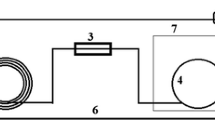Abstract
Nowadays, the geographical origin of camellia oil (extra virgin) can be confirmed only by chemical analysis and documental traceability. This preliminary methodological study inquires the efficacy of chemometric analysis and gas chromatography coupled to an electronic nose to provide a rapid tool for the discrimination of camellia oil from different geographical origins. This method is appropriate for serving to support or corroborate geographical origin of camellia oil (extra virgin) based on its fingerprint of volatile profile, which is developed by using discriminant analysis and multivariate ordination technique (partial least squares discriminant analysis and principal components analysis). The results demonstrate that chemometrics combined with the electronic nose technique can be applied for fingerprinting to establish the authenticity of camellia oil (extra virgin) to prevent both quality and prestige loss of this product.






Similar content being viewed by others
References
Ali H, Saleem M, Anser MR, Khan S, Ullah R, Bilal M (2018) Validation of fluorescence spectroscopy to detect adulteration of edible oil in extra virgin olive oil (EVOO) by applying chemometrics. Appl Spectrosc 72(9):1371–1379
Andrikopoulos NK, Giannakis IG, Tzamtzis V (2001) Analysis of olive oil and seed oil triglycerides by capillary gas chromatography as a tool for the detection of the adulteration of olive oil. J Chromatogr Sci 39(4):137
Angelis A, Antoniadi L, Stathopoulos P, Halabalaki M, Skaltsounis LA (2018) Oleocanthalic and oleaceinic acids: new compounds from extra virgin olive oil (EVOO). Phytochem Lett 26:190–194
Aparicio-Ruiz R, García-González D, Lobo-Prieto A, Aparicio R (2019) Andalusian protected designations of origin of virgin olive oil: the role of chemical composition in their authentication. Eur J Lipid Sci Tech 121(3):1800133
Charlebois S, Sterling B, Haratifar S, Naing SK (2014) Comparison of global food traceability regulations and requirements. Compr Rev Food Sci F 13(5):1104–1123
Christopoulou E, Lazaraki M, Komaitis M, Kaselimis K (2004) Effectiveness of determinations of fatty acids and triglycerides for the detection of adulteration of olive oils with vegetable oils. Food Chem 84(3):463–474
Diniz PHGD, Gomes AA, Pistonesi MF, Band BSF, Araújo MCUD (2014) Simultaneous classification of teas according to their varieties and geographical origins by using NIR spectroscopy and SPA-LDA. Food Anal Method 7(8):1712–1718
Karn A, Heim C, Flint-Garcia S, Bilyeu K, Gillman J (2017) Development of rigorous fatty acid near-infrared spectroscopy quantitation methods in support of soybean oil improvement. J Am Oil Chem Soc 94(1):69–76
Liu W, Liu C, Yu J, Zhang Y, Li J, Chen Y, Zheng L (2018) Discrimination of geographical origin of extra virgin olive oils using terahertz spectroscopy combined with chemometrics. Food Chem 251:86–92
Majchrzak T, Wojnowski W, Dymerski T, Gębicki J, Namieśnik J (2018) Electronic noses in classification and quality control of edible oils: a review. Food Chem 246:192–201
Mansour AB, Chtourou F, Khbou W, Flamini G, Bouaziz M (2017) Phenolic and volatile compounds of Neb Jmel olive oil cultivar according to their geographical origin using chemometrics. Eur Food Res Technol 243(3):403–418
Mihailova A, Abbado D, Kelly SD, Pedentchouk N (2015) The impact of environmental factors on molecular and stable isotope compositions of n-alkanes in Mediterranean extra virgin olive oils. Food Chem 173:114–121
Peng Q, Tian R, Chen F, Li B, Gao H (2015) Discrimination of producing area of Chinese Tongshan kaoliang spirit using electronic nose sensing characteristics combined with the chemometrics methods. Food Chem 178:301–305
Peng Q, Xu X, Xing W, Hu B, Shen C, Tian R, Li X, Xu Q, Chen J, Chen F (2017) Ageing status characterization of Chinese spirit using scent characteristics combined with chemometric analysis. Innov Food Sci Emerg Technol 44:212–216
Popkin BM (2011) Agricultural policies, food and public health. EMBO Rep 12(1):11–18
Safar M, Bertrand D, Robert P, Devaux M, Genot C (1994) Characterization of edible oils, butters and margarines by Fourier transform infrared spectroscopy with attenuated total reflectance. J Am Oil Chem Soc 71(4):371
Shen F, Ying Y, Li B, Zheng Y, Zhuge Q (2011) Multivariate classification of rice wines according to ageing time and brand based on amino acid profiles. Food Chem 129(2):565–569
Shen F, Wu J, Ying Y, Li B, Jiang T (2013) Differentiation of Chinese rice wines from different wineries based on mineral elemental fingerprinting. Food Chem 141(4):4026–4030
Snyder J, Frankel E, Selke E (1985) Capillary gas chromatographic analyses of headspace volatiles from vegetable oils. J Am Oil Chem Soc 62(12):1675
Tabatabai S, Knadel M, Thomsen A, Greve MH (2019) On-the-Go sensor fusion for prediction of clay and organic carbon using pre-processing survey, different validation methods, and variable selection. Soil Sci Soc Am J 83(2):300–310
Uncu O, Ozen B (2015) Prediction of various chemical parameters of olive oils with Fourier transform infrared spectroscopy. LWT-Food Sci Technol 63(2):978–984
Villegas L, Benavente F, Sanz-Nebot V, Grases JM, Barbosa J (2018) A rapid and simple method for the analysis of bioactive compounds in olive oil refining by-products by liquid chromatography with ultraviolet and mass spectrometry detection. J Food Compos Anal 69:107–114
Wojnowski W, Majchrzak T, Dymerski T, Gębicki J, Namieśnik J (2017) Portable electronic nose based on electrochemical sensors for food quality assessment. Sensors 17(12):2715
Yao F, Yi B, Shen C, Tao F, Liu Y, Lin Z, Xu P (2015) Chemical analysis of the Chinese liquor Luzhoulaojiao by comprehensive two-dimensional gas chromatography/time-of-flight mass spectrometry. Sci Rep 5:9553
Yuan J, Wang C, Chen H, Zhou H, Ye J (2013) Prediction of fatty acid composition in Camellia oleifera oil by near infrared transmittance spectroscopy (NITS). Food Chem 138(2–3):1657–1662
Zhu W, Wang X, Chen L (2017) Rapid detection of peanut oil adulteration using low-field nuclear magnetic resonance and chemometrics. Food Chem 216:268–274
Acknowledgements
This work was supported by Zhejiang Provincial Natural Science Foundation of China under Grant No. 2017C32101; Foundation of Public Projects of Shaoxing city, Zhejiang Province, China (No. 2018C30010); Science and Technology Innovation Program and New Talents Program for College Students in Zhejiang Province in 2018 (2018R432011).
Author information
Authors and Affiliations
Corresponding author
Ethics declarations
Conflict of interest
The authors declare that they have no conflict of interest.
Additional information
Publisher's Note
Springer Nature remains neutral with regard to jurisdictional claims in published maps and institutional affiliations.
Rights and permissions
About this article
Cite this article
Peng, Q., Xu, Q., Dula, B.G. et al. Discrimination of geographical origin of camellia seed oils using electronic nose characteristics and chemometrics. J Consum Prot Food Saf 15, 263–270 (2020). https://doi.org/10.1007/s00003-020-01278-x
Received:
Revised:
Accepted:
Published:
Issue Date:
DOI: https://doi.org/10.1007/s00003-020-01278-x




